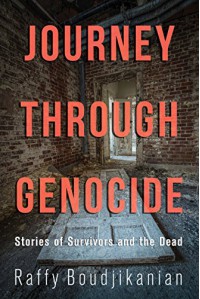Journey Through Genocide: Stories of Survivors and Dead

His grandparents were survivors of the Armenian Genocide of 1915 and this is what inspired Raffy to dream of a trip, which allowed him to visit every country which had experienced a genocide in the 20th century. As the calendar moved into the 21st century, Raffy knew that he needed to start planning his trip. The world was not changing for genocides were still occurring, the word was out but nothing was being done to stop them. Finances made his dream trip impossible, so Raffy scaled back his trip and began his planning.
I found when I read this novel that it was more about Raffy’s journey visiting the cities than it was about visiting the individuals who were affected by the genocides. I read the synopsis a few times while reading this novel, as “stories of survivors and dead” was what I was looking forward to reading about and I had a hard time finding this in the novel. I felt the synopsis led me astray. This was a journey but it covered more about Raffy’s travels to the cities and his experiences in the cities than about speaking to individuals about the genocides.
I did discover that many of the individuals who did the killings are on the run and some that did end up in court, were let go. It seemed that the common thread was that many individuals will not acknowledge that the genocides took place. If they can’t admit to this, then a trial nor a verdict can occur and justice cannot be provided for those whose lives have been affected. The survivors must live in limbo. Some survivors fear of history repeating itself, some live their lives in frustration and/or some are hurt. They live in a world where reality is a dark cloud and they are waiting for someone to shed some light on the situation. In the novel, there was a report where the number of deaths in the village was so large that the remaining villagers created mass graves. These graves were quicker to prepare and the villagers were also afraid that the offenders would return and murder more of the villagers. That is not all, when the authorities came to the village to check out the damage, nothing was done, no further action was taken. How could the authorities walk away from such devastation and do nothing?
Some of the novel’s illustrations were wonderful, they showed the history/cities and gave the story more meaning. The novel was very descriptive and I enjoyed that about this novel. This novel was Raffy’s journey to find more information on genocides. It was about his travels: what he experienced, what he saw, and how things are. I enjoyed the novel but I was expecting more in the way of interviews and/or information about the genocides.
I received a copy of this novel from NetGalley and DunDurn in exchange for an honest review.






